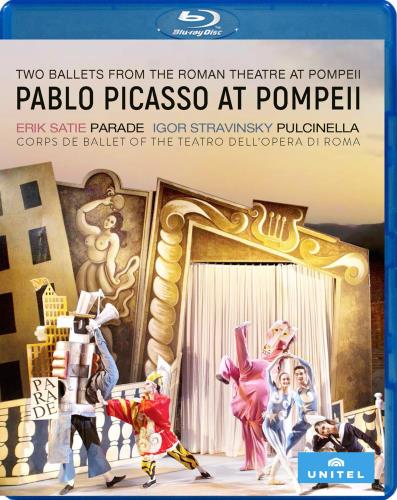
Pablo Picasso at Pompeii
Two ballets from the Roman Theatre of Pompeii
| Quelle |  |
| EAN | 4058407094401 |
| Lieferbarkeit | lieferbar |
| Katalogisat | Basiskatalogisat |
| Verlag | Monarda Music GmbH/Arthaus Musik |
| Erscheinungsdatum | 20.08.2021 |
Beschreibung (Langtext)
Vor der malerischen Kulisse des legendären Vesuv liegt das antike Theater von Pompeji. Anlässlich des 100. Jahrestages von Pablo Picassos Besuch an ebenjener Wirkungsstätte, präsentiert das Ballett des Teatro dell’Opera di Roma zu Ehren des spanischen Künstlers eine farbenfrohe Open-Air-Veranstaltung mit zwei Balletten, zu denen Picasso selbst einst Bühnenbild und Kostüme entworfen hatte: Erik Saties „Parade“ und Igor Stravinskys „Pulcinella“. Die beiden Ballette verbindet außerdem ihre Choreografiehistorie, für die der russische Starchoreograph Leonide Massine zu Lebzeiten verantwortlich zeichnete.
Der Corps de Ballet des Teatro dell’Opera di Roma unter der Leitung der Pariser Prima-Ballerina Eleonora Abbagnato, die selbst aus dem Süden Italiens stammt, und Leonide Massines Sohn Lorca Massine gelingt eine Aufführung, die den Bühnenglanz des vergangenen Jahrhunderts in neues Licht rückt.
Against the picturesque backdrop of the Vesuvius, the ancient Roman Theatre of Pompeii hosts a colourful open air event in honour of Pablo Picasso. Celebrating the centenary of his visit to Italy, two ballets with sets and costumes designed by
this legendary Spanish artist are put on stage: Parade, with music by Erik Satie, and Igor Stravinsky’s Pulcinella. The choreography of both works has been created by Russian ballet star Léonide Massine. It is performed by the corps de ballet of the Teatro dell’Opera di Roma under the direction of Paris Opera prima ballerina Eleonora Abbagnato and Léonide Massine’s son Lorca as choreographer.
100 years ago, together with Jean Cocteau, Picasso undertook a journey to Naples and Pompeii in order to work on Parade, an avantgarde ballet commissioned by Serge Diaghilev, director of the famous Ballets Russes, which was supposed to be
inspired by Neapolitan folklore and the commedia dell’arte. The stage curtain of Parade is the largest work Picasso ever completed, measuring about 11 meters high by 17 meters wide. Cocteau’s libretto tells the story of a troupe of street artists
who parade in front of a crowd of onlookers in an attempt to attract an audience for their show.
